+ Open data
Open data
- Basic information
Basic information
| Entry | Database: PDB / ID: 6hcq | |||||||||||||||
|---|---|---|---|---|---|---|---|---|---|---|---|---|---|---|---|---|
| Title | Structure of the rabbit collided di-ribosome (collided monosome) | |||||||||||||||
 Components Components |
| |||||||||||||||
 Keywords Keywords | RIBOSOME / Translation / Quality Control | |||||||||||||||
| Function / homology |  Function and homology information Function and homology informationribosomal subunit / positive regulation of signal transduction by p53 class mediator / ubiquitin ligase inhibitor activity / phagocytic cup / 90S preribosome / ribosomal small subunit export from nucleus / rough endoplasmic reticulum / translation regulator activity / gastrulation / MDM2/MDM4 family protein binding ...ribosomal subunit / positive regulation of signal transduction by p53 class mediator / ubiquitin ligase inhibitor activity / phagocytic cup / 90S preribosome / ribosomal small subunit export from nucleus / rough endoplasmic reticulum / translation regulator activity / gastrulation / MDM2/MDM4 family protein binding / cytosolic ribosome / class I DNA-(apurinic or apyrimidinic site) endonuclease activity / DNA-(apurinic or apyrimidinic site) lyase / maturation of LSU-rRNA from tricistronic rRNA transcript (SSU-rRNA, 5.8S rRNA, LSU-rRNA) / ribosomal large subunit biogenesis / positive regulation of apoptotic signaling pathway / maturation of SSU-rRNA from tricistronic rRNA transcript (SSU-rRNA, 5.8S rRNA, LSU-rRNA) / maturation of SSU-rRNA / small-subunit processome / spindle / mRNA 5'-UTR binding / antimicrobial humoral immune response mediated by antimicrobial peptide / rRNA processing / rhythmic process / positive regulation of canonical Wnt signaling pathway / regulation of translation / large ribosomal subunit / ribosome binding / ribosomal small subunit biogenesis / ribosomal small subunit assembly / small ribosomal subunit / 5S rRNA binding / ribosomal large subunit assembly / cytosolic small ribosomal subunit / large ribosomal subunit rRNA binding / small ribosomal subunit rRNA binding / defense response to Gram-negative bacterium / killing of cells of another organism / perikaryon / cytosolic large ribosomal subunit / cytoplasmic translation / cell differentiation / tRNA binding / mitochondrial inner membrane / postsynaptic density / rRNA binding / ribosome / structural constituent of ribosome / translation / ribonucleoprotein complex / cell division / DNA repair / mRNA binding / apoptotic process / synapse / centrosome / dendrite / negative regulation of apoptotic process / nucleolus / perinuclear region of cytoplasm / endoplasmic reticulum / Golgi apparatus / DNA binding / RNA binding / zinc ion binding / nucleus / cytosol / cytoplasm Similarity search - Function | |||||||||||||||
| Biological species |  | |||||||||||||||
| Method | ELECTRON MICROSCOPY / single particle reconstruction / cryo EM / Resolution: 6.5 Å | |||||||||||||||
 Authors Authors | Juszkiewicz, S. / Chandrasekaran, V. / Lin, Z. / Kraatz, S. / Ramakrishnan, V. / Hegde, R.S. | |||||||||||||||
| Funding support |  United Kingdom, United Kingdom,  France, 4items France, 4items
| |||||||||||||||
 Citation Citation |  Journal: Mol Cell / Year: 2018 Journal: Mol Cell / Year: 2018Title: ZNF598 Is a Quality Control Sensor of Collided Ribosomes. Authors: Szymon Juszkiewicz / Viswanathan Chandrasekaran / Zhewang Lin / Sebastian Kraatz / V Ramakrishnan / Ramanujan S Hegde /  Abstract: Aberrantly slow translation elicits quality control pathways initiated by the ubiquitin ligase ZNF598. How ZNF598 discriminates physiologic from pathologic translation complexes and ubiquitinates ...Aberrantly slow translation elicits quality control pathways initiated by the ubiquitin ligase ZNF598. How ZNF598 discriminates physiologic from pathologic translation complexes and ubiquitinates stalled ribosomes selectively is unclear. Here, we find that the minimal unit engaged by ZNF598 is the collided di-ribosome, a molecular species that arises when a trailing ribosome encounters a slower leading ribosome. The collided di-ribosome structure reveals an extensive 40S-40S interface in which the ubiquitination targets of ZNF598 reside. The paucity of 60S interactions allows for different ribosome rotation states, explaining why ZNF598 recognition is indifferent to how the leading ribosome has stalled. The use of ribosome collisions as a proxy for stalling allows the degree of tolerable slowdown to be tuned by the initiation rate on that mRNA; hence, the threshold for triggering quality control is substrate specific. These findings illustrate how higher-order ribosome architecture can be exploited by cellular factors to monitor translation status. | |||||||||||||||
| History |
|
- Structure visualization
Structure visualization
| Movie |
 Movie viewer Movie viewer |
|---|---|
| Structure viewer | Molecule:  Molmil Molmil Jmol/JSmol Jmol/JSmol |
- Downloads & links
Downloads & links
- Download
Download
| PDBx/mmCIF format |  6hcq.cif.gz 6hcq.cif.gz | 4.7 MB | Display |  PDBx/mmCIF format PDBx/mmCIF format |
|---|---|---|---|---|
| PDB format |  pdb6hcq.ent.gz pdb6hcq.ent.gz | Display |  PDB format PDB format | |
| PDBx/mmJSON format |  6hcq.json.gz 6hcq.json.gz | Tree view |  PDBx/mmJSON format PDBx/mmJSON format | |
| Others |  Other downloads Other downloads |
-Validation report
| Summary document |  6hcq_validation.pdf.gz 6hcq_validation.pdf.gz | 1.8 MB | Display |  wwPDB validaton report wwPDB validaton report |
|---|---|---|---|---|
| Full document |  6hcq_full_validation.pdf.gz 6hcq_full_validation.pdf.gz | 2 MB | Display | |
| Data in XML |  6hcq_validation.xml.gz 6hcq_validation.xml.gz | 377.8 KB | Display | |
| Data in CIF |  6hcq_validation.cif.gz 6hcq_validation.cif.gz | 636.5 KB | Display | |
| Arichive directory |  https://data.pdbj.org/pub/pdb/validation_reports/hc/6hcq https://data.pdbj.org/pub/pdb/validation_reports/hc/6hcq ftp://data.pdbj.org/pub/pdb/validation_reports/hc/6hcq ftp://data.pdbj.org/pub/pdb/validation_reports/hc/6hcq | HTTPS FTP |
-Related structure data
| Related structure data |  0197MC  0192C  0194C  0195C  6hcfC  6hcjC  6hcmC M: map data used to model this data C: citing same article ( |
|---|---|
| Similar structure data |
- Links
Links
- Assembly
Assembly
| Deposited unit | 
|
|---|---|
| 1 |
|
- Components
Components
-RNA chain , 7 types, 7 molecules 517181A2q3v333
| #1: RNA chain | Mass: 1177882.250 Da / Num. of mol.: 1 / Source method: isolated from a natural source / Source: (natural)  |
|---|---|
| #2: RNA chain | Mass: 38691.914 Da / Num. of mol.: 1 / Source method: isolated from a natural source / Source: (natural)  |
| #3: RNA chain | Mass: 50143.648 Da / Num. of mol.: 1 / Source method: isolated from a natural source / Source: (natural)  |
| #4: RNA chain | Mass: 602779.812 Da / Num. of mol.: 1 / Source method: isolated from a natural source / Source: (natural)  |
| #79: RNA chain | Mass: 23874.191 Da / Num. of mol.: 1 / Source method: isolated from a natural source / Source: (natural)  |
| #82: RNA chain | Mass: 6972.146 Da / Num. of mol.: 1 / Source method: isolated from a natural source / Source: (natural)  |
| #83: RNA chain | Mass: 24231.510 Da / Num. of mol.: 1 / Source method: isolated from a natural source / Source: (natural)  |
+Protein , 50 types, 50 molecules B2D2E2F2J2L2O2P2Q2S2T2U2V2W2Y2Z2a2b2e2h2B3C3F3G3H3L3O3P3Q3R3...
-40S ribosomal protein ... , 6 types, 6 molecules C2H2I2N2c2f2
| #6: Protein | Mass: 30002.061 Da / Num. of mol.: 1 / Source method: isolated from a natural source / Source: (natural)  |
|---|---|
| #11: Protein | Mass: 28751.906 Da / Num. of mol.: 1 / Source method: isolated from a natural source / Source: (natural)  |
| #12: Protein | Mass: 22168.914 Da / Num. of mol.: 1 / Source method: isolated from a natural source / Source: (natural)  |
| #17: Protein | Mass: 14538.987 Da / Num. of mol.: 1 / Source method: isolated from a natural source / Source: (natural)  |
| #32: Protein | Mass: 9480.186 Da / Num. of mol.: 1 / Source method: isolated from a natural source / Source: (natural)  |
| #35: Protein | Mass: 14498.884 Da / Num. of mol.: 1 / Source method: isolated from a natural source / Source: (natural)  |
-Ribosomal protein ... , 15 types, 15 molecules G2K2M2R2X2d2g2A3J3M3N3V3Y3j3u3
| #10: Protein | Mass: 22913.453 Da / Num. of mol.: 1 / Source method: isolated from a natural source / Source: (natural)  |
|---|---|
| #14: Protein | Mass: 22641.564 Da / Num. of mol.: 1 / Source method: isolated from a natural source / Source: (natural)  |
| #16: Protein | Mass: 18468.826 Da / Num. of mol.: 1 / Source method: isolated from a natural source / Source: (natural)  |
| #21: Protein | Mass: 16477.377 Da / Num. of mol.: 1 / Source method: isolated from a natural source / Source: (natural)  |
| #27: Protein | Mass: 14865.555 Da / Num. of mol.: 1 / Source method: isolated from a natural source / Source: (natural)  |
| #33: Protein | Mass: 7855.052 Da / Num. of mol.: 1 / Source method: isolated from a natural source / Source: (natural)  |
| #36: Protein | Mass: 18004.041 Da / Num. of mol.: 1 / Source method: isolated from a natural source / Source: (natural)  |
| #38: Protein | Mass: 28088.863 Da / Num. of mol.: 1 / Source method: isolated from a natural source / Source: (natural)  |
| #47: Protein | Mass: 20288.465 Da / Num. of mol.: 1 / Source method: isolated from a natural source / Source: (natural)  |
| #49: Protein | Mass: 23870.549 Da / Num. of mol.: 1 / Source method: isolated from a natural source / Source: (natural)  |
| #50: Protein | Mass: 24207.285 Da / Num. of mol.: 1 / Source method: isolated from a natural source / Source: (natural)  |
| #58: Protein | Mass: 14892.505 Da / Num. of mol.: 1 / Source method: isolated from a natural source / Source: (natural)  |
| #60: Protein | Mass: 17303.363 Da / Num. of mol.: 1 / Source method: isolated from a natural source / Source: (natural)  |
| #71: Protein | Mass: 11111.032 Da / Num. of mol.: 1 / Source method: isolated from a natural source / Source: (natural)  |
| #81: Protein | Mass: 17847.619 Da / Num. of mol.: 1 / Source method: isolated from a natural source / Source: (natural)  |
-60S ribosomal protein ... , 5 types, 5 molecules D3E3I3Z3i3
| #41: Protein | Mass: 34481.828 Da / Num. of mol.: 1 / Source method: isolated from a natural source / Source: (natural)  |
|---|---|
| #42: Protein | Mass: 33028.336 Da / Num. of mol.: 1 / Source method: isolated from a natural source / Source: (natural)  |
| #46: Protein | Mass: 24643.057 Da / Num. of mol.: 1 / Source method: isolated from a natural source / Source: (natural)  |
| #61: Protein | Mass: 15835.831 Da / Num. of mol.: 1 / Source method: isolated from a natural source / Source: (natural)  |
| #70: Protein | Mass: 12263.834 Da / Num. of mol.: 1 / Source method: isolated from a natural source / Source: (natural)  |
-Protein/peptide , 2 types, 2 molecules n31
| #75: Protein/peptide | Mass: 3473.451 Da / Num. of mol.: 1 / Source method: isolated from a natural source / Source: (natural)  |
|---|---|
| #85: Protein/peptide | Mass: 1581.727 Da / Num. of mol.: 1 / Source method: isolated from a natural source / Source: (natural)  |
-Non-polymers , 2 types, 308 molecules 


| #86: Chemical | ChemComp-MG / #87: Chemical | ChemComp-ZN / |
|---|
-Details
| Has protein modification | Y |
|---|
-Experimental details
-Experiment
| Experiment | Method: ELECTRON MICROSCOPY |
|---|---|
| EM experiment | Aggregation state: PARTICLE / 3D reconstruction method: single particle reconstruction |
- Sample preparation
Sample preparation
| Component | Name: Rabbit 80S on globin mRNA in the rotated state with A/P and P/E tRNAs Type: RIBOSOME / Entity ID: #1-#85 / Source: NATURAL |
|---|---|
| Molecular weight | Value: 4.3 MDa / Experimental value: NO |
| Source (natural) | Organism:  |
| Buffer solution | pH: 7.4 |
| Specimen | Embedding applied: NO / Shadowing applied: NO / Staining applied: NO / Vitrification applied: YES |
| Vitrification | Cryogen name: ETHANE |
- Electron microscopy imaging
Electron microscopy imaging
| Experimental equipment |  Model: Titan Krios / Image courtesy: FEI Company |
|---|---|
| Microscopy | Model: FEI TITAN KRIOS |
| Electron gun | Electron source:  FIELD EMISSION GUN / Accelerating voltage: 300 kV / Illumination mode: FLOOD BEAM FIELD EMISSION GUN / Accelerating voltage: 300 kV / Illumination mode: FLOOD BEAM |
| Electron lens | Mode: BRIGHT FIELD |
| Image recording | Electron dose: 1.79 e/Å2 / Detector mode: INTEGRATING / Film or detector model: FEI FALCON III (4k x 4k) |
- Processing
Processing
| CTF correction | Type: PHASE FLIPPING AND AMPLITUDE CORRECTION |
|---|---|
| 3D reconstruction | Resolution: 6.5 Å / Resolution method: FSC 0.143 CUT-OFF / Num. of particles: 14634 / Symmetry type: POINT |
 Movie
Movie Controller
Controller



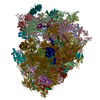
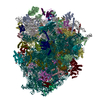
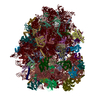

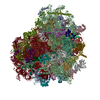

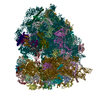
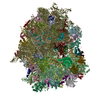


 PDBj
PDBj
































